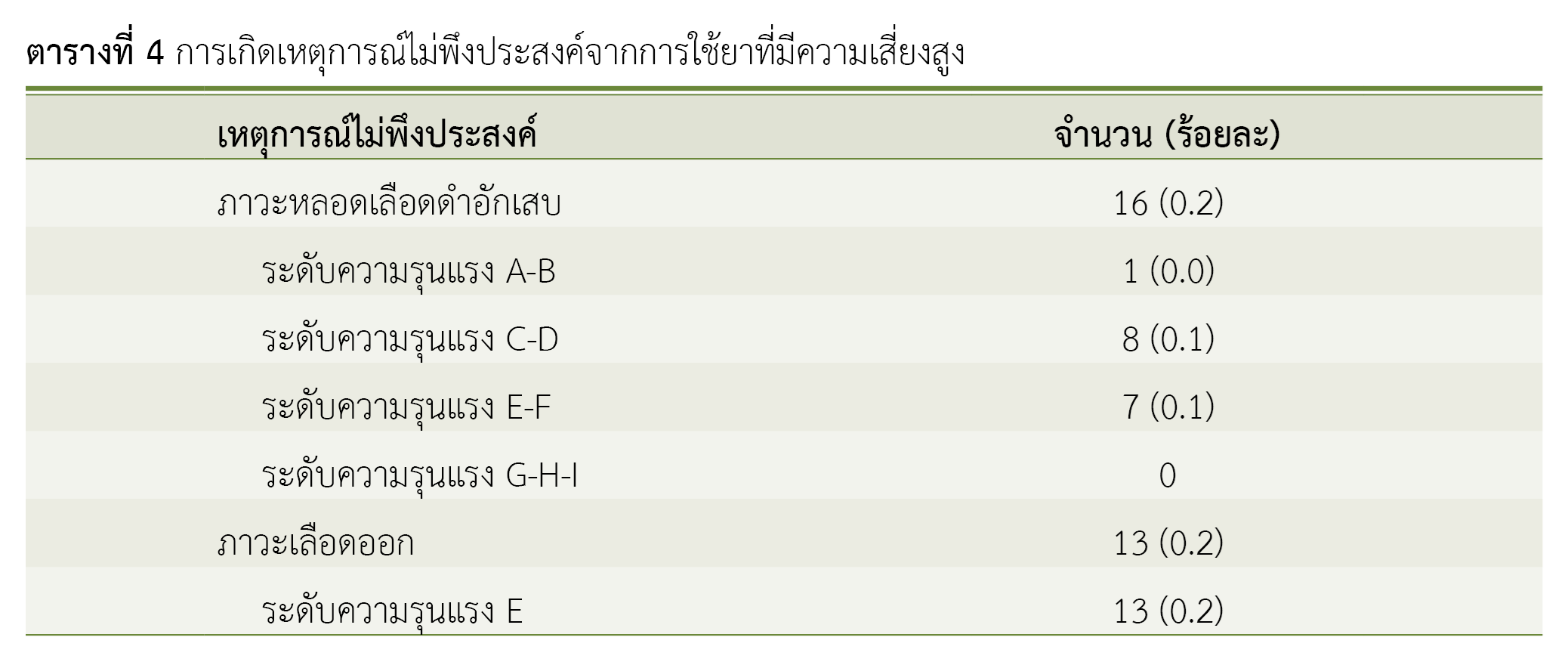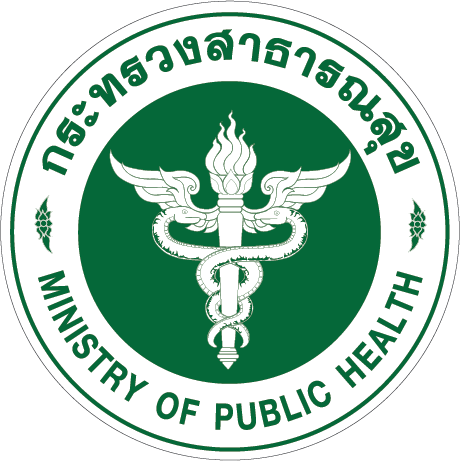Medication Errors and Adverse Drug Events in Patients Taking High Alert Drugs, Lamphun Hospital
Keywords:
high alert drugs, medication errors, adverse drug eventAbstract
Background: Medication errors and adverse drug events are the major problems encountered in the medication process and has an effect on causing patient’s health problems, increased cost, longer hospitalizations and may be severe enough to cause death.
Objectives: To study the incidence of medication errors and the occurrence of adverse drug events in patients taking high alert drugs and analyze factors associated with the incidence of medication errors and the occurrence of adverse drug events in patients taking high alert drugs.
Method: This was a descriptive research with retrospective data collection. The sample group was inpatients at Lamphun Hospital who received 14 high alert drugs between 1 January 2022 and 31 December 2022, a total of 6,917 cases. Data were collected from medical records and risk management information system of Lamphun Hospital.
Results: Most patients taking high alert drugs were male (55.1%), over 60 years old (64.5%), had no history of drug allergy (84.5%), and had no underlying diseases (74.5%). High alert drugs were used 6,917 times. The most frequently used high alert drugs included magnesium sulphate (17.6%), followed by norepinephrine (17.0%) and potassium chloride (14.7%). High alert drugs were used in the intensive care unit the most, 47.7%. Medication errors were found from dispensing 0.4%. Occurrence of adverse drug events were phlebitis 0.2% and bleeding 0.2%. Basic patient factors include being over 60 years old and having underlying diseases were statistically significant associated with the incidence of medication errors and the occurrence of adverse drug events at the 0.05 level.
Conclusion: The medication errors and adverse drug events in patients taking high alert drugs affect patient safety. It is also essential to follow-up and monitor the use of high alert drugs in elderly patients with underlying diseases.
References
Institute for Safe Medication Practices (ISMP). ISMP’s list of high-alert medications [Internet]. Plymouth Meeting (PA): Institute for Safe Medication Practices; 2007 [cited 2023 Jul 4]. Available from: https://www.nursingworld.org/~4afce7/globalassets/practiceandpolicy/innovation--evidence/high-alert-medications-list.pdf
World Health Organization (WHO). Medication without harm [Internet]. Geneva: World Health Organization; 2020 [cited 2023 Jul 4]. Available from: https://www.who.int/initiatives/medication-without-harm
National Coordinating Council for Medication Error Reporting and Prevention. Types of medication errors [Internet]. n.p.: National Coordinating Council for Medication Error Reporting and Prevention; 2022 [cited 2023 Jul 4]. Available from: https://www.nccmerp.org/types-medication-errors
Younis I, Shaheen N, Bano S. Knowledge & practice about administration of high alert medication in the tertiary care hospital in Lahore. IJHMNP. 2021;3(4):1-16. doi: 10.47941/ijhmnp.644.
กิตติพนธ์ เครือวังค์. ความคลาดเคลื่อนทางยา. วารสารกฎหมายสุขภาพและสาธารณสุข [อินเทอร์เน็ต]. 2561 [สืบค้นเมื่อ 5 เม.ย. 2566];4(2):251-265. สืบค้นจาก: https://so05.tci-thaijo.org/index.php/journal_law/article/view/161437
ปัญญฉัตร ซอสุขไพบูลย์. ระบบรายงานความคลาดเคลื่อนทางยาจากโปรแกรมคอมพิวเตอร์ที่พัฒนาขึ้นในโรงพยาบาลขนาดใหญ่แห่งหนึ่ง. วารสารเภสัชกรรมไทย [อินเทอร์เน็ต]. 2555 [สืบค้นเมื่อ 5 เม.ย. 2566];4(1):3-16. สืบค้นจาก: https://he01.tci-thaijo.org/index.php/TJPP/article/view/169294
สำนักคณะกรรมการอาหารและยา. สรุปรายงานเหตุการณ์ไม่พึงประสงค์จากการใช้ยา ประจำปี พ.ศ. 2564. นนทบุรี: ศูนย์เฝ้าระวังความปลอดภัยด้านผลิตภัณฑ์สุขภาพ สำนักคณะกรรมการอาหารและยา; 2564.
สถาบันรับรองคุณภาพสถานพยาบาล (องค์การมหาชน). เป้าหมายความปลอดภัยของผู้ป่วยของประเทศไทย พ.ศ. 2561. กรุงเทพฯ: เฟมัส แอนด์ ซัคเซสฟูล; 2561.
โรงพยาบาลลำพูน. รายงานอุบัติการณ์ความคลาดเคลื่อนทางยาที่มีความเสี่ยงสูง. ลำพูน: โรงพยาบาลลำพูน; 2565.
เพียงเพ็ญ ชนาเทพาพร. การพัฒนาระบบการติดตามและเฝ้าระวังการใช้ยาที่มีความเสี่ยงสูงในโรงพยาบาลศรีนครินทร์. ศรีนครินทร์เวชสาร [อินเทอร์เน็ต]. 2558 [สืบค้นเมื่อ 4 เม.ย. 2566];30(1):46-56. สืบค้นจาก: https://li01.tci-thaijo.org/index.php/SRIMEDJ/article/view/33581
รพีพรรณ เกิดหนู. การประเมินการดำเนินงานตามแนวทางการใช้ยาที่มีความเสี่ยงสูงของโรงพยาบาลปราณบุรี [อินเทอร์เน็ต]. ประจวบคีรีขันธ์: โรงพยาบาลปราณบุรี ประจวบคีรีขันธ์; 2564 [สืบค้นเมื่อ 5 เม.ย. 2566]. สืบค้นจาก: https://โรงพยาบาลปราณบุรี.com/th/pages/41556-ผลงานวิชาการ
Laatikainen O, Sneck S, Turpeinen M. The risks and outcomes resulting from medication errors reported in the Finnish tertiary care units: a cross-sectional retrospective register study. Front Pharmacol. 2020;10:1571. doi: 10.3389/fphar.2019.01571.
เจตนิพัทธ์ มิดขุนทด. การพัฒนาระบบการจัดการด้านยาที่มีความเสี่ยงสูงโรงพยาบาลตาคลี ภายใต้ความร่วมมือของทีมสหวิชาชีพ. วารสารวิทยาศาสตร์สุขภาพแห่งประเทศไทย [อินเทอร์เน็ต]. 2564 [สืบค้นเมื่อ 4 เม.ย. 2566];3(3):39-51. สืบค้นจาก: https://he02.tci-thaijo.org/index.php/HSJT/article/view/249506
วิวัฒน์ ถาวรวัฒนยงค์, จตุพร อโณทยานนท์, นิรมล เรืองสกุล, พัลลภ ศรีภิรมย์รักษ์,รินพัท ชมจันทร์. การใช้ยาที่มีความเสี่ยงสูงในผู้สูงอายุ : กรณีศึกษาตำบลวังตะกู จังหวัดนครปฐม. วารสารวิจัยระบบสาธารณสุข [อินเทอร์เน็ต]. 2554 [สืบค้นเมื่อ 5 เม.ย. 2566];5(2):187-194. สืบค้นจาก: https://kb.hsri.or.th/dspace/bitstream/handle/11228/3248/hsri-journal-v5n2-p187-194.pdf?sequence=3&isAllowed=y

Downloads
Published
How to Cite
Issue
Section
License
Copyright (c) 2024 Health Administration Division, Office of the Permanent Secretary, Ministry of Public Health and The Society of Hospital Pharmacist, Ministry of Public Health

This work is licensed under a Creative Commons Attribution-NonCommercial-NoDerivatives 4.0 International License.
ข้อความภายในบทความที่ตีพิมพ์ในวารสารเภสัชกรรมคลินิกทั้งหมด รวมถึงรูปภาพประกอบ ตาราง เป็นลิขสิทธิ์ของกองบริหารการสาธารณสุข สำนักงานปลัดกระทรวงสาธารณสุข และ ชมรมเภสัชกรโรงพยาบาลกระทรวงสาธารณสุข การนำเนื้อหา ข้อความหรือข้อคิดเห็น รูปภาพ ตาราง ของบทความไปจัดพิมพ์เผยแพร่ในรูปแบบต่าง ๆ เพื่อใช้ประโยชน์ในเชิงพาณิชย์ ต้องได้รับอนุญาตจากกองบรรณาธิการวารสารเภสัชกรรมคลินิกอย่างเป็นลายลักษณ์อักษร
กองบริหารการสาธารณสุข สำนักงานปลัดกระทรวงสาธารณสุข และ ชมรมเภสัชกรโรงพยาบาลกระทรวงสาธารณสุข อนุญาตให้สามารถนำไฟล์บทความไปใช้ประโยชน์และเผยแพร่ต่อได้ โดยอยู่ภายใต้เงื่อนไขสัญญาอนุญาตครีเอทีฟคอมมอน (Creative Commons License: CC) โดย ต้องแสดงที่มาจากวารสาร – ไม่ใช้เพื่อการค้า – ห้ามแก้ไขดัดแปลง, Attribution-NonCommercial-NoDerivatives 4.0 International (CC BY-NC-ND 4.0)
ข้อความที่ปรากฏในบทความในวารสารเป็นความคิดเห็นส่วนตัวของผู้เขียนแต่ละท่านไม่เกี่ยวข้องกับกองบริหารการสาธารณสุข สำนักงานปลัดกระทรวงสาธารณสุข และ ชมรมเภสัชกรโรงพยาบาลกระทรวงสาธารณสุข และบุคลากรในกองฯ หรือ ชมรมฯ แต่อย่างใด ความรับผิดชอบองค์ประกอบทั้งหมดของบทความแต่ละเรื่องเป็นของผู้เขียนแต่ละท่าน หากมีความผิดพลาดใด ๆ ผู้เขียนแต่ละท่านจะรับผิดชอบบทความของตนเอง ตลอดจนความรับผิดชอบด้านเนื้อหาและการตรวจร่างบทความเป็นของผู้เขียน ไม่เกี่ยวข้องกับกองบรรณาธิการ



